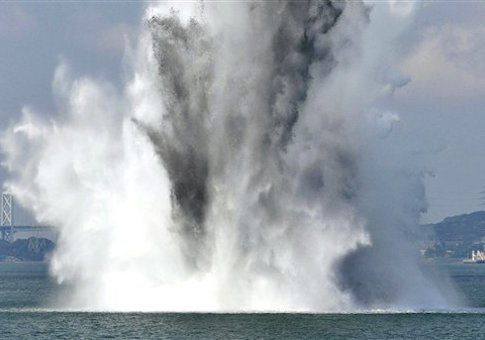After nearly five years of development, the Navy's multi-million dollar unmanned undersea vehicle has not yet demonstrated its ability to find and identify mines, according to a partially-redacted report released by the Pentagon's inspector general last week that sheds light on the problems with the high-tech mine-hunter.
The 20-foot-long, 1,300-pound unmanned undersea vehicle will work to detect, avoid, and identify mines on the floor of the ocean. The Knifefish, currently under development by General Dynamics Mission Systems and Bluefin Robotics, is one of several unmanned systems that the Navy plans to deploy from its littoral combat ship, the service's newest family of naval craft.
The Navy will use the unmanned systems instead of dolphins and other marine mammals that the service currently uses to detect mines on the ocean floor.
However, budget cuts and management problems have compromised development of the Knifefish, which is currently described as "high risk" by personnel and may not be ready for the planned initial production between July and September of next year.
As a result, the Defense Department's inspector general wants program officials to review whether the program should be continued or whether the more than $750 million the Pentagon plans to spend on it in the future should be allocated elsewhere. The Navy could waste millions of dollars developing the unmanned system without it demonstrating that it will be successful on the battlefield, the watchdog warned.
"If the Knifefish cannot meet its primary requirement to detect, classify, and identify mines, the Navy could spend an additional $751.5 million in remaining funds for Knifefish research, development, test, and evaluation; procurement; and operations and management to procure and sustain a system that may not achieve the capability originally planned," auditors concluded.
Between April 2015 and August 2016, the inspector general reviewed the Navy's Knifefish program, finding that developers failed to establish requirements for the unmanned system related to its communication with and launch and recovery from the littoral combat ship. This "lack of coordination," the investigation found, resulted in development scheduling delays and more than $2 million in program cost increases.
Auditors also faulted Navy managers for not effectively planning or testing the Knifefish amid shortfalls in funding. Specifically, program leaders and contractors shortened test schedules to alleviate delays, shrinking the development testing period from 21 months to nine months.
"Because the program office condensed developmental testing schedules and combined test events, the program is at risk of not being able to correct design problems identified during testing," the inspector general concluded.
Congress cut funds to the Knifefish program by more than $10 million between fiscal years 2012 and 2016, forcing Navy officials to alter the contract for the system. As of February 2016, the program office had received roughly $91 million of the baseline funding for developing the Knifefish.
The problems with the Knifefish are indicative of how budget constraints have affected the military's attempts to obtain advanced technology as emerging adversaries make investments in their own forces.
U.S. military leaders have repeatedly warned of the toll that sequestration and the 2011 Budget Control Act are having on readiness and modernization. the four service chiefs testified in September before the Senate Armed Services Committee that their forces will not be able to defend the homeland if sequestration persists.
The Knifefish had not demonstrated its mine-hunting capabilities as of March 2016, leading personnel to express concerns about the system's success in the future, according to the newly-released report.
"Knifefish program office personnel reported the Knifefish minehunting capability as high risk, even after almost 5 years of development," the inspector general wrote. "The Knifefish program office personnel further reported that if the Knifefish cannot meet its primary requirement to detect, classify, and identify mines, errors could result in an excessive number of mine danger areas, and will unnecessarily delay mine clearance operations."
Program leaders are conducting operational testing of the Knifefish—during which military users will test the unmanned system under "realistic conditions"—during the current quarter of this fiscal year. The system faces an initial production decision in the fourth quarter of fiscal year 2017 and a full-rate production decision one year after that.
A Navy spokesman directed the Washington Free Beacon to the responses from the director of the Navy's Expeditionary Warfare Division and the Commander of Naval Sea Systems Command included in the report.
Both leaders disagreed with several conclusions of the investigation, including the inspector general's finding that service managers failed to define requirements having to do with the interaction between the unmanned system and the littoral combat ship.
The Navy is expected to spend $842.5 million on the Knifefish program when costs for research, development, testing, procurement, and operation are totaled.
